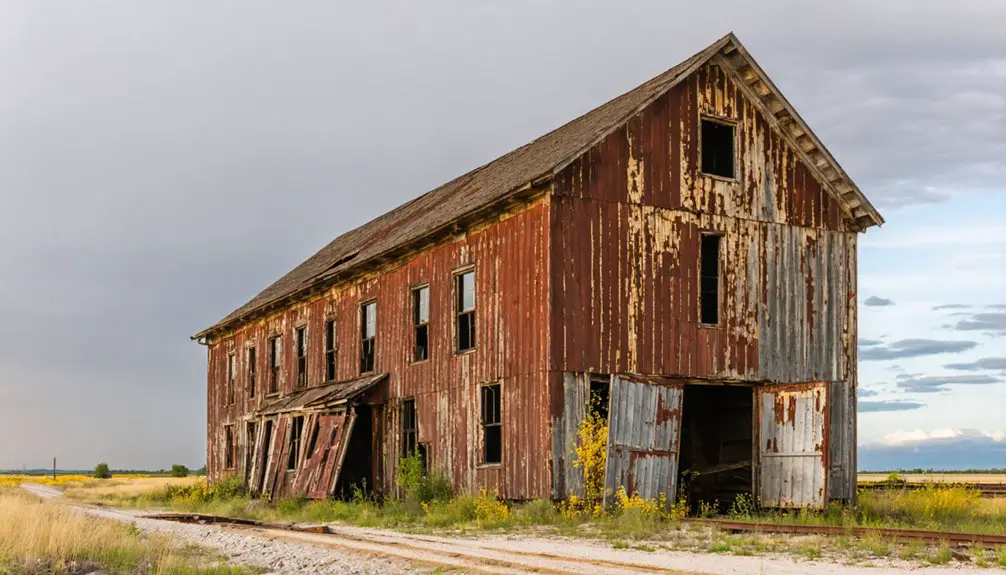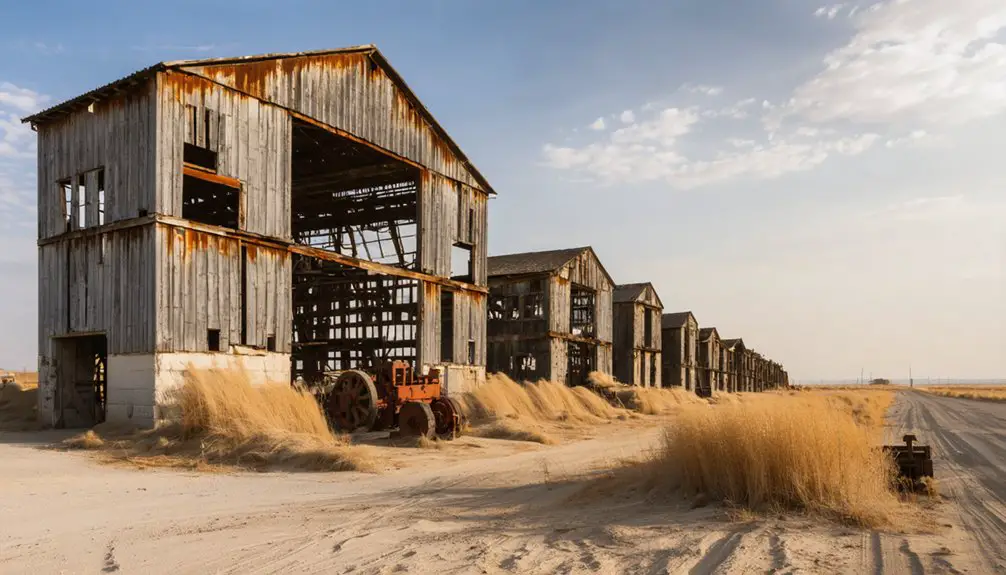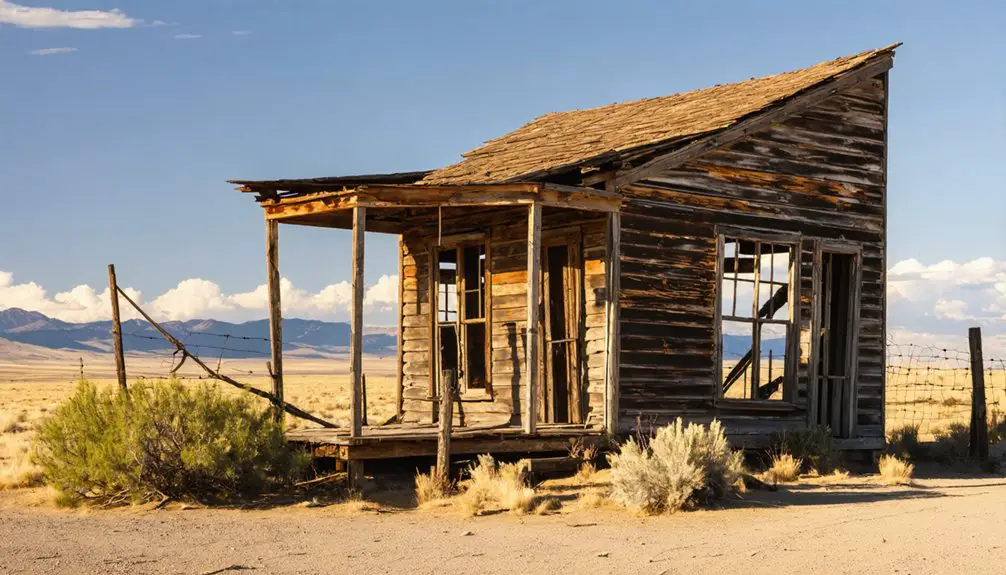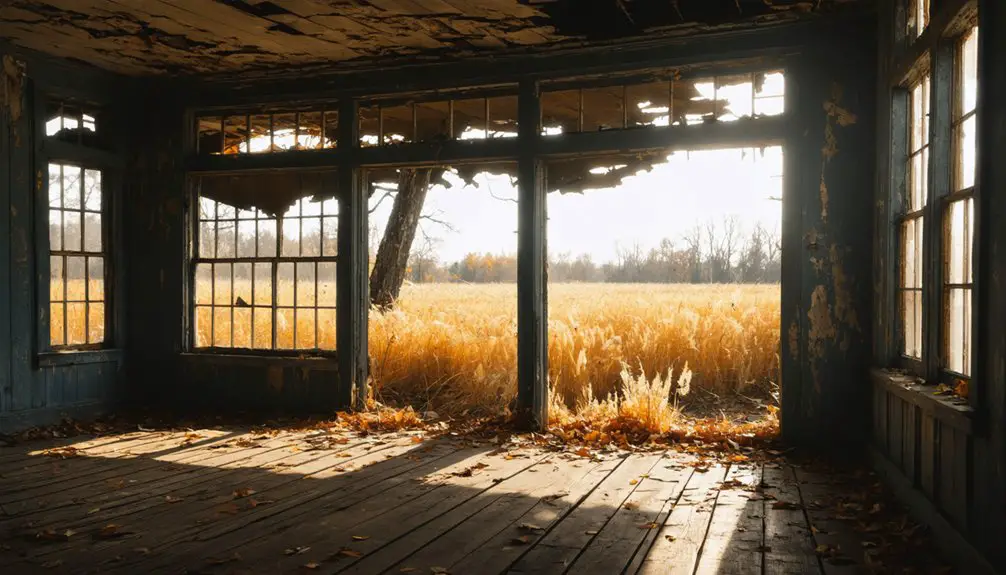You’ll find Ortley a mile south of Rowena, Oregon, where a planned agricultural community once dreamed big in 1911. With a $200,000 investment, the Hood River Orchard & Land Company established this ambitious apple-growing settlement, complete with a post office, hotel, and school. Despite early promise, harsh winds and poor soil conditions crushed farming aspirations. By 1924, the post office closed, and Ortley’s brief chapter in Oregon’s history offers compelling insights into frontier development’s risks.
Key Takeaways
- Ortley was established in 1911 as a planned agricultural community in Oregon, focused primarily on apple cultivation and farming.
- Located about a mile south of Rowena, the town developed infrastructure including a post office, hotel, school, and shops.
- Environmental challenges, poor soil conditions, and harsh winds led to widespread crop failures and economic hardship.
- The post office closed in 1924, marking a significant decline as families abandoned their farms due to agricultural failures.
- Today, no physical structures remain of Ortley, and the site sits on private land inaccessible to the public.
The Birth of an Apple Town (1911)
While many Oregon towns emerged around logging or mining, Ortley began in 1911 as a meticulously planned agricultural community centered on apple cultivation.
Breaking from Oregon’s resource-extraction roots, Ortley emerged in 1911 as a deliberate experiment in agricultural town planning.
You’ll find its origins in the vision of Hood River Orchard & Land Company, which invested $200,000 to create a European-style settlement where fruit growers could live near their orchards.
The community planning was ambitious, offering both residential and orchard plots to prospective settlers.
You’d have found one-acre home lots paired with larger 5-10 acre parcels for commercial growing.
The mild climate conditions made the location initially attractive to agricultural developers and settlers.
The town, named after the Ortley apple variety, quickly developed essential infrastructure including a post office, hotel, school, and shops.
Positioned dramatically on a Columbia River bluff, this specialized “apple town” aimed to become a worldwide hub for its namesake fruit.
Like many entries requiring disambiguation pages, Ortley’s historical significance spans multiple locations and contexts beyond just this Oregon settlement.
Life in Early Ortley
As Ortley’s first settlers established their homesteads in 1911, you’d have found a tight-knit community of farming families adapting to frontier life.
Like many settlers who received free land grants under the Donation Land Act, your daily routines would’ve centered around tending orchards and livestock, with community interactions built on labor sharing and economic exchanges through bartering.
You’d have lived in a modest wooden home, heated by wood stoves, without modern amenities like plumbing or electricity.
Transportation limitations and primitive roads would’ve isolated you during harsh weather, making social gatherings precious occasions, much like the early settlers who faced similar challenges with impassable roads in Linnton.
Your children’s educational opportunities likely began at home or in small schoolhouses, while cultural influences from your Midwestern roots shaped local traditions.
Family structures remained traditional, with each household contributing to farming practices and participating in informal events like harvest festivals and barn raisings.
Agricultural Dreams and Harsh Realities
You’ll find that early Ortley settlers arrived with grand visions of prosperous apple orchards and bountiful harvests, mirroring the agricultural successes they’d witnessed in the Willamette Valley.
Your understanding of their struggle deepens when you consider how the harsh winds and challenging soil conditions steadily eroded their farming ambitions, despite their use of fertilizers and adaptation of various farming techniques. Some residents eventually sought assistance at county poor farms when their agricultural ventures failed completely.
Like other white farmers who had successfully established dairy farming by 1845 in areas like Clatsop County, Ortley’s settlers hoped to transform their land into productive agricultural enterprises.
You can trace Ortley’s gradual decline through the withering of these agricultural dreams, as farmers faced the harsh realities of drought, inconsistent crop yields, and unstable market prices that eventually led many to abandon their lands.
Hopes of Apple Harvests
When the Hood River Orchard & Land Company established Ortley in 1911, they envisioned a thriving apple-growing community centered around the namesake Ortley apple variety.
You would’ve found settlers flocking to this promising venture, drawn by the region’s established success with apple varieties like Newtown, Pippin, and Spitzenberg. The town quickly grew to 300 residents, complete with a post office, shops, and a hotel – all evidence of the community’s aspirations.
The timing seemed perfect, as Oregon’s fruit industry was experiencing remarkable growth. The Hudson’s Bay Company had proven decades earlier that apples could thrive in Northwest soil.
Building on horticultural knowledge dating back to 1847, when pioneers first brought grafted trees west, Ortley’s developers were confident they’d create another success story in the state’s flourishing apple industry.
The community’s enthusiasm matched the bold vision of its founders. The developers could point to the success of established commercial orchards, as J.H. Stewart had made the first successful fruit shipment just two decades earlier in 1890.
Soil and Wind Challenges
Despite the promising vision for Ortley’s apple orchards, the harsh realities of the region’s soil conditions and relentless winds posed significant challenges to agricultural success.
You’d find yourself battling clay loams that turned rock-hard in dry weather and became unworkably plastic when wet. Without proper wind protection, your crops would suffer as the persistent gusts stripped away precious topsoil through soil erosion. Farmers could have benefited from consulting detailed soil maps to better understand the land’s limitations.
The area’s drainage problems didn’t help either. In the flat, open landscape, your fields would often become waterlogged, and you’d need artificial drainage systems just to keep the land farmable. Even with proper management, farms required organic matter replenishment to maintain any reasonable productivity.
When you could grow crops, you’d see modest yields at best – wheat and oats might give you 20-30 bushels per acre, reflecting the soil’s limited productivity and the constant struggle against nature’s elements.
Withering of a Dream
As dreams of agricultural prosperity faded in Ortley, farmers faced mounting pressures from all directions.
You’d have seen community aspirations crumble as rising production costs and distant market dependencies squeezed profit margins. Despite agricultural innovation in irrigation and farming techniques, the harsh environmental realities proved relentless.
Japanese immigrants, who’d transformed from laborers to landowners, exemplified both the possibilities and limitations of farming success.
While they’d managed to control significant acreage by 1910, the broader community struggled. The combination of seasonal labor challenges, economic strain, and unreliable crop yields pushed many families to abandon their farms.
What began as a vision of self-sufficient farming communities withered into poor farms and institutional operations.
Ortley’s shift to a ghost town reflected the collapse of these once-hopeful agricultural dreams.
A Community’s Brief Rise

You’ll find Ortley’s origins in the ambitious 1908 vision of Hood River businessmen who invested $200,000 to establish a European-style apple-growing community on Oregon’s frontier.
Within months of the town’s 1911 platting, nearly 300 settlers flocked to purchase both residential lots and orchard parcels, drawn by the promise of agricultural prosperity.
The swift population influx brought essential services to Ortley, including a post office, school, hotel, and various shops that supported the burgeoning community’s development.
Vision of Apple Prosperity
When the Hood River Orchard & Land Company established Ortley in 1911, they envisioned a thriving agricultural community centered around the promising Ortley apple variety.
You would’ve seen ambitious settlers purchasing small orchard parcels, drawn by the potential of Oregon’s booming fruit industry, which was already flourishing with Newtown, Spitzenberg, and Jonathan apple varieties.
The community vision took shape through carefully planned infrastructure – a post office, hotel, and shops emerged to support what developers hoped would be a bustling population of orchard workers and their families.
In these early days, you’d have witnessed the excitement as town lots were sold and orchards were planted, all part of a broader movement to establish fruit-growing communities throughout Oregon’s fertile regions.
Swift Population Growth
The swift establishment of Ortley’s town lots and orchard parcels in 1911 triggered a remarkable population surge, with nearly 300 residents flocking to the area within months.
You’d have witnessed a diverse mix of ambitious settlers, drawn by the Hood River Orchard & Land Company’s promise of agricultural prosperity and independence.
These immigrant experiences reflected the pioneering spirit of the era, as young families and entrepreneurs established roots in the burgeoning community.
Their orchard aspirations fueled rapid development, with essential amenities quickly following – a post office, shops, and a hotel sprung up to serve the growing population.
While many settlers were transient, speculating on the town’s future success, they all shared a common dream: building wealth through Ortley’s promised apple-growing potential.
Early Business Development
Following Ortley’s establishment in 1911, a modest but vibrant commercial district emerged to support the growing population of orchard workers and their families.
The Hood River Orchard & Land Company’s community planning efforts centered on creating a self-sufficient agricultural hub, with apple orchards as its economic foundation.
You’d have found essential businesses including a post office, several shops, and a hotel serving both residents and visitors.
The company’s vision shaped Ortley’s development through strategic land sales and controlled development patterns typical of early 20th-century company towns.
However, the town’s commercial aspirations faced significant hurdles. Environmental challenges, particularly water scarcity and strong winds, severely limited orchard productivity.
Environmental Challenges That Doomed Ortley

Plagued by relentless coastal erosion and devastating storm damage, Ortley’s fate was sealed by a perfect storm of environmental challenges that emerged in the early 20th century.
You’ll find that by 1926, oceanic forces had already begun undermining essential structures, while continuous sand loss threatened the town’s very foundation.
- Your town’s protective barriers crumbled as storms relentlessly battered the coastline, leading to catastrophic infrastructure collapse.
- You couldn’t stop the 1952 breach that allowed sand to pour into Tillamook Bay, burying your community’s hopes beneath its weight.
- Your local industries – oyster beds and dairy farms – succumbed to saltwater intrusion and sand inundation.
- Your critical transportation links failed as the only road to the mainland gave way to nature’s fury.
The lack of adequate infrastructure protection sealed Ortley’s destiny, making abandonment inevitable.
The Town’s Swift Decline
Following a series of farming setbacks due to poor soil conditions in the early 1900s, you’d have witnessed Ortley’s rapid population exodus that left only a handful of determined residents by 1920.
The closure of Ortley’s post office in 1924 marked a critical turning point, effectively severing the town’s last essential communication link to the outside world.
Within just two decades, what you’d once recognize as a hopeful farming settlement transformed into an abandoned townsite, with most buildings either collapsed or removed for materials.
Population Exodus Timeline
While Ortley initially flourished as a bustling Oregon settlement during the late 19th century, its population decline began swiftly in the early 20th century when new railroad routes bypassed the town.
The population dynamics shifted dramatically as residents sought opportunities elsewhere, creating distinct migration patterns that would seal the town’s fate.
- Families began departing in waves as local businesses shuttered their doors
- Young generations left to pursue work in better-connected neighboring towns
- By mid-century, only a handful of determined residents remained
- The last inhabitants departed by the late 20th century, leaving Ortley to the elements
This exodus transformed Ortley from a thriving community into another Oregon ghost town, serving as a stark reminder of how quickly fortunes can change when economic lifelines are severed.
Environmental Farming Setbacks
Agricultural challenges dealt a devastating blow to Ortley’s survival when environmental regulations and invasive species began reshaping Oregon’s farming landscape in the mid-20th century.
You’d have witnessed mounting agricultural tensions as Governor McCall’s environmental policies restricted farm operations near growing towns, while the spread of Himalayan blackberry choked out productive land.
The economic squeeze tightened as conservation mandates forced farmers to adopt costly sustainable practices. While these requirements aimed to prevent soil erosion and water pollution, they hit Ortley’s farmers particularly hard.
You couldn’t expand your operations due to new land-use laws, and trying to compete with less-regulated regions became nearly impossible. The introduction of mechanical plowing had inadvertently welcomed invasive species, permanently altering the local ecosystem and ultimately contributing to the town’s abandonment.
Post Office Closure Impact
As the U.S. Postal Service consolidated operations across Oregon, Ortley’s closure dealt a devastating blow to this rural community.
The loss of postal services triggered a cascade of economic and social challenges that accelerated the town’s decline.
- Local businesses struggled with delivery challenges, facing multi-day delays as mail had to route through Portland’s regional hub before reaching Ortley.
- Infrastructure loss forced residents to travel to neighboring towns for basic postal services, straining elderly mobility.
- Communication disruption isolated families, particularly during harsh weather when rural roads became impassable.
- Economic effects rippled through the community as mailing delays hampered commerce, driving away the remaining merchants.
The post office closure symbolized more than lost convenience – it marked the severance of Ortley’s lifeline to the outside world, hastening its transformation into a ghost town.
Legacy of a Failed Settlement
Despite its ambitious vision and substantial initial investment, Ortley’s rapid decline has left an enduring mark on Oregon’s development history.
You’ll find this ghost town serves as a stark reminder of how essential environmental assessment is before establishing agricultural settlements.
What makes Ortley’s agricultural legacy particularly significant is how it demonstrates the consequences of overlooking natural barriers to farming success.
The town’s founders learned the hard way that Columbia Gorge winds and inconsistent water supplies could devastate even the most promising apple orchards.
Today, you can learn from their $200,000 mistake, which proved that successful settlements require more than just capital and optimism – they need thorough analysis of climate, terrain, and resources.
Ortley’s failure continues to inform modern development practices throughout the Pacific Northwest.
What Remains Today

The physical traces of Ortley have completely vanished from Oregon’s landscape. Unlike other ghost towns in the region that preserve their historical significance through standing structures, you’ll find no remnants of this once-hopeful settlement.
The site, located about a mile south of Rowena, now lies on private land that’s inaccessible to the public.
- No foundations remain where the post office and hotel once stood
- Not a single wall or building survives to mark the town’s existence
- No interpretative signs tell the story of this forgotten place
- No artifacts remain visible on the surface to hint at past human activity
Today, Ortley exists only in historical records and plat maps, its physical presence erased by time and the elements.
Lessons From Ortley’s Story
Looking back at Ortley’s brief existence, you’ll find a wealth of cautionary lessons about frontier development and community planning.
The town’s swift collapse reveals the dangers of basing an entire community’s future on a single crop without proper environmental research. You can see how the lack of economic diversification left Ortley vulnerable when its apple orchards failed due to harsh winds and unreliable water supplies.
The $200,000 investment and rapid growth to 300 residents shows how quickly frontier dreams can materialize – and vanish.
To build lasting communities, you need more than optimism and infrastructure; you need thorough environmental assessments and strategies for community resilience. Ortley’s ghost town status serves as a stark reminder that successful settlements require careful planning and adaptation to natural conditions.
Preserving Ortley’s Memory
While Ortley’s physical structures have largely vanished, dedicated preservation efforts guarantee its story lives on through regional archives and historical societies.
Historical documentation projects have established a rich collection of artifacts, photographs, and written records that capture Ortley’s pioneering spirit and economic significance to Oregon’s development.
Through ghost town preservation initiatives, you can explore Ortley’s legacy in several meaningful ways:
- Visit local museums featuring exhibits of mining tools and daily life artifacts from Ortley’s heyday
- Study historical photographs comparing Ortley’s bustling past to its current state
- Participate in guided educational tours that bring the town’s stories to life
- Access digitized newspaper archives revealing firsthand accounts of life in early Ortley
State Historic Preservation Office markers now stand where buildings once did, ensuring future generations can connect with this piece of Oregon’s heritage.
Frequently Asked Questions
Are There Any Living Descendants of Original Ortley Settlers Still in Oregon?
Like scattered seeds lost to the wind, descendant stories and family connections from original Ortley settlers have vanished into history. You won’t find any documented living descendants in Oregon today.
What Happened to the Property Titles of Abandoned Ortley Lots?
You’ll find the original property titles remained legally recorded with Wasco County, though post-abandonment title claims were likely complicated by tax issues and property disputes as lands merged into larger private holdings.
Did Any Other Towns Attempt Apple Orchards in the Area Afterwards?
With 15,000 apple trees by 1897, you’ll find Weeks & Orr near Medford led successful apple farming ventures. Despite orchard challenges, towns like Hood River Valley and Ashland continued thriving in fruit production.
Were There Any Notable Crimes or Incidents During Ortley’s Brief Existence?
You won’t find any documented crime history or unusual incidents in Ortley’s brief existence. Available records show a peaceful agricultural community that failed due to environmental challenges rather than criminal activity.
What Was the Average Price of an Ortley Town Lot in 1911?
You won’t find documented records of Ortley lot prices from 1911, though historical land values in comparable Oregon ghost towns suggest lots might’ve sold for anywhere between $50-200 during that period.
References
- https://en.wikipedia.org/wiki/Ortley
- https://traveloregon.com/things-to-do/culture-history/ghost-towns/oregon-ghost-towns/
- https://en.wikipedia.org/wiki/List_of_ghost_towns_in_Oregon
- https://www.youtube.com/watch?v=dBCOeX8_ItY
- http://www.photographoregon.com/ghost-towns.html
- https://www.ghosttowns.com/states/or/ortley.html
- http://www.wascocountypioneerassociation.org/wasco-county-towns/
- https://www.hoodriverhistorymuseum.org/ortleys/
- https://homepages.rootsweb.com/~westklic/howcoc1.html
- https://historicoregoncity.org/2019/04/02/early-towns-and-cities/



